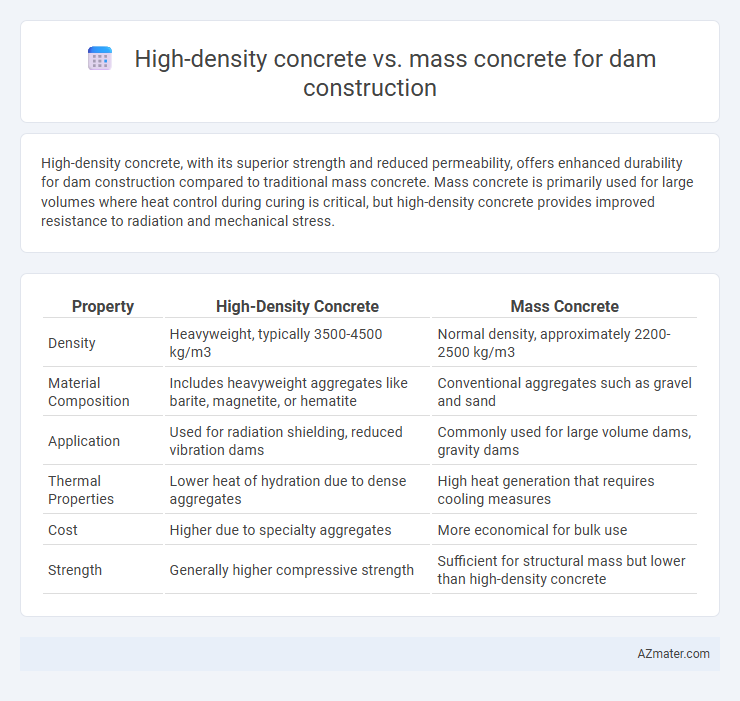High-density concrete, with its superior strength and reduced permeability, offers enhanced durability for dam construction compared to traditional mass concrete. Mass concrete is primarily used for large volumes where heat control during curing is critical, but high-density concrete provides improved resistance to radiation and mechanical stress.
Table of Comparison
| Property | High-Density Concrete | Mass Concrete |
|---|---|---|
| Density | Heavyweight, typically 3500-4500 kg/m3 | Normal density, approximately 2200-2500 kg/m3 |
| Material Composition | Includes heavyweight aggregates like barite, magnetite, or hematite | Conventional aggregates such as gravel and sand |
| Application | Used for radiation shielding, reduced vibration dams | Commonly used for large volume dams, gravity dams |
| Thermal Properties | Lower heat of hydration due to dense aggregates | High heat generation that requires cooling measures |
| Cost | Higher due to specialty aggregates | More economical for bulk use |
| Strength | Generally higher compressive strength | Sufficient for structural mass but lower than high-density concrete |
Introduction to Dam Construction Materials
High-density concrete, characterized by its high specific gravity and enhanced radiation shielding properties, is increasingly used in dam construction to improve durability and structural performance in challenging environments. Mass concrete, traditionally employed in dam projects, is designed for large volume pours with controlled temperature to prevent thermal cracking, using ordinary aggregates and cementitious materials. Selecting between high-density and mass concrete depends on project-specific requirements such as load-bearing capacity, environmental conditions, and long-term maintenance considerations.
Understanding High-Density Concrete
High-density concrete, characterized by its increased density through the use of heavyweight aggregates like barytes or magnetite, provides enhanced radiation shielding and improved structural stability in dam construction compared to traditional mass concrete. This type of concrete achieves densities ranging from 3000 to 4500 kg/m3, significantly higher than normal mass concrete, which typically ranges between 2200 to 2500 kg/m3. Its superior compressive strength and reduced permeability make high-density concrete ideal for critical dam components where durability and resistance to chemical attack are paramount.
Overview of Mass Concrete
Mass concrete, commonly used in dam construction, is characterized by its large volume and low heat generation during curing, reducing thermal stresses and preventing cracking. It typically consists of ordinary Portland cement, aggregates, and water, designed to achieve strength and durability under immense loads while maintaining cost-effectiveness. High-density concrete differs by incorporating heavy aggregates like barite or magnetite to increase density and radiation shielding, whereas mass concrete primarily focuses on thermal management and structural stability.
Key Properties of High-Density Concrete
High-density concrete exhibits a higher density typically ranging from 3,800 to 6,000 kg/m3, achieved by incorporating heavy aggregates like barite, magnetite, or hematite, enhancing radiation shielding and structural stability in dam construction. Its superior compressive strength often exceeds 70 MPa, providing increased durability and resistance to underwater pressure compared to standard mass concrete, which generally ranges from 2,300 to 2,500 kg/m3 in density. The reduced porosity and enhanced thermal conductivity of high-density concrete minimize thermal cracks and improve long-term performance in massive dam structures.
Key Properties of Mass Concrete
Mass concrete for dam construction exhibits critical properties such as low heat of hydration to minimize thermal cracking, high durability under varying environmental conditions, and substantial compressive strength to withstand immense structural loads. Its low permeability ensures reduced water ingress, enhancing the longevity and stability of the dam. Control of temperature gradients within mass concrete is essential to prevent internal stresses, making thermal management a pivotal aspect of its design and application.
Applications of High-Density Concrete in Dam Projects
High-density concrete, with its enhanced density typically achieved by incorporating heavy aggregates like hematite or magnetite, is used in dam construction to provide superior radiation shielding and reduce seepage through its lower permeability. In dam projects, high-density concrete is specifically applied in critical zones such as spillways, upstream faces, and powerhouses where radiation from hydroelectric equipment or durability under aggressive environmental conditions is a concern. Its ability to minimize hydrostatic pressure and improve structural stability makes it an optimal choice compared to traditional mass concrete in specialized dam components.
Mass Concrete Usage in Dam Construction
Mass concrete is crucial in dam construction due to its ability to efficiently withstand high compressive loads and thermal stresses during curing. This type of concrete features a low heat of hydration, which minimizes thermal cracking in large volumes typical of dam structures. Its dense composition enhances durability and impermeability, ensuring long-term structural integrity under varying environmental conditions.
Advantages and Limitations: High-Density vs Mass Concrete
High-density concrete offers superior strength and durability, making it ideal for sections of dams requiring enhanced load-bearing capacity and radiation shielding, while mass concrete excels in large-volume pours due to its lower heat of hydration and cost-effectiveness. However, high-density concrete is more expensive and difficult to handle because of its heavy aggregates, limiting its use to specific dam components. Mass concrete faces challenges related to thermal cracking and requires careful temperature control during curing, which can increase construction complexity and time.
Durability and Performance Comparison
High-density concrete, with its superior compressive strength and reduced permeability, offers enhanced durability compared to mass concrete in dam construction, effectively resisting chemical attacks and abrasion. Mass concrete, while economical and suitable for bulk placement, can experience thermal cracking due to heat of hydration, which may compromise long-term performance. The high-density mix improves structural integrity and longevity, making it a preferred choice for critical dam sections exposed to aggressive environments.
Choosing the Right Concrete Type for Your Dam Project
High-density concrete, with its enhanced strength and radiation shielding properties, is ideal for dams requiring high durability and resistance to dynamic loads, while mass concrete is preferred for its thermal stability and cost-effectiveness in large-volume pours. Selecting the right concrete type depends on the dam's design specifications, load conditions, and environmental factors such as temperature control during curing. Evaluating factors like compressive strength, density, heat generation, and project budget ensures optimal performance and longevity of the dam structure.

Infographic: High-density concrete vs Mass concrete for Dam construction
 azmater.com
azmater.com